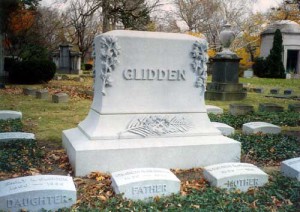
There is a tendency, I think, to imagine that our ancestors moved around far less than we do, that they were parked in one spot for years at a time – perhaps they were born, married, and died in the same place. If, in fact, they emigrated to another country, this was a one-time thing, for by doing so they must have exhausted their wanderlust.
The experience of my own ancestors refutes this truism, although I certainly do have forebears who stayed in one place for generations at a time. One part of my mother’s family is a good example: Her great-grandfather, William Pierce Harrington Glidden (1830–1913), was one of a large family born to Joseph Glidden of Newcastle, Maine (1791–1855), and his two wives, Emily Harrington (1798–1836) and Mary Otis Taylor (1811–1874).[1]
Maine, Virginia, and Louisiana
Joseph and Emily’s first surviving child, Emily Harrington Glidden (1819–1897), married twice and lived for years with her second husband, Captain George Frost Blunt Leighton (1816–1905), at Tanners Creek in Norfolk County, Virginia. The next two sons married local girls and stayed in Newcastle and Portland, Maine, but then the next two daughters wed ship captains and died, young, in New Orleans.
South Carolina, New York, and Ohio
Mary Myrick Glidden (1828–1901) was next, and she married William Francis Joy of Boston. But this marriage between New Englanders took place in Georgetown, South Carolina, on the eve of the Civil War. My great-great-grandfather was the next child, and he married his landlady’s stepdaughter (Jane Letitia Hughes) in Brooklyn, New York, before following his younger brother to Cleveland, Ohio.
Alabama and Ohio
Francis Harrington Glidden (1832–1922) wed his second cousin Winifred Kavanagh Waters and then, like some of his elder sisters, moved south: in his case it was to Mobile, Alabama, and family legend tells that he spent the Civil War years as a prisoner of war there. During the 1860s both William and Frank Glidden found work as paint and varnish salesmen, and by the early 1870s were (briefly) partners in their own varnish company: this venture, under Uncle Frank Glidden’s guidance, and with other partners, became what is today the Glidden Paint Company.
The last of Joseph and Emily (Harrington) Glidden’s children was Jeanette (Nettie), who was brought up by (and with the name of) her uncle and aunt Simon and Jane (Glidden) Handley; even after her father remarried she remained with the Handley family. Her Webb descendants, like the Joys, settled in Boston.
Joseph and Mary Otis (Taylor) Glidden had three more children: Katharine Augusta Glidden (b. 1841), Priscilla Child Glidden (b. 1843),[2] and James P. Glidden (b. 1846). Kate and Priscilla married brothers, William P. Porter and Walter S. Porter of Georgetown, South Carolina. By 1880, Aunt Kate Porter’s son John was living in Cleveland, in the household of my great-great-grandparents, while Aunt Kate and her other children were in Tanners Creek with the Leightons. These family ties were tenacious, it would seem, no matter what the distance!
Notes
[1] See Rev. David Quimby Cushman, The History of Ancient Sheepscot and Newcastle… (Bath, Me.: E. Upton & Son, Printers, 1882), pp. 383–84.
[2] Named for her older half-sister, Priscilla (Glidden) Child (1824–1842).
Nice post Scott. Good to see a diverse pattern in the ‘scattering’ of a family. It is interesting to me to see your north/south pattern – and slightly westward to Ohio. Was there any extreme westward migration of your family past Ohio? No California kin? My own New England lines seems so typical in that they merged with the old Chesapeake Bay “pack” – and it then it was all “westward ho” onto Kansas City, and the Oregon Trail. – Way too typical I am!
Best regards,
Jeff Record
Thanks, Jeff! My great-grandfather went east, to Baltimore; his daughter, my grandmother, married a naval officer and lived in California and Hawaii (and Maryland and Virginia); and my mother married a Bostonian. My mother used to tell me, with surprising specificity, about some of her Joy and Webb cousins in Boston and Baltimore — my grandmother had obviously filled her in!
Glad you posted this topic! I find people tend to think our ancestors were sedentary, but I’ve found few after New England was settled that did stay put. An anectodal example: William Carpenter family of early Reheboth, Mass. They stayed there for a good long time, but as land became unavailable, they went west. Daniel Carpenter’s family, within just a few generations, went over the Cumberland gap and moved through Kentucky, Indiana, Missouri, Iowa and landed in Colorado. Daniel’s brother Nathaniel’s family moved through New Hampshire, Vermont, upstate New York, Michigan, Wisconsin and on to Colorado. My parents were respective descendants of those two brothers. Which probably explains why my family used to argue so much about whether I looked just like my maternal grandmother or my Dad!
I’m too lazy to look this up, but on a similar moving note, I heard that in New York City there was a set “moving day”, where residents settled up with the landlord and all moved on about the same day of the year. My husband’s greatgrandfather used to travel overseas on business a lot, and often came home to find a note on the door telling him where his new address was—wife and kids just went ahead and moved! I’m always amazed when looking at city directories, especially here in Denver a century ago, that people seemed to move every year or two. Most often it was only a few blocks away.
I love the way you analyzed one family and their travels. It’s a great way to personalize them and also to find out what happened to orphaned strays.
I really enjoyed this post – so much so that I wrote a blog post of my own similar family history experience, which is here:
http://www.eightroadstomontana.com/surnamelinks/buchenau/from-pennsylvania-to-montana/ Thanks for the idea!